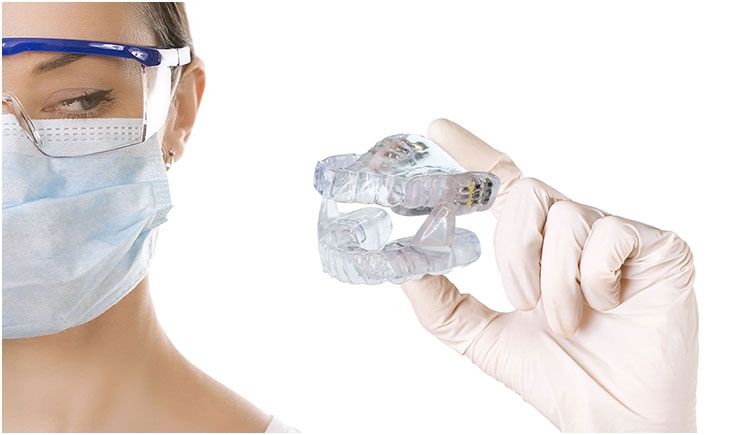
Attention to sleep-related breathing disorders has increased due to growing public awareness, a better understanding by the medical and dental communities on the role dentists may play in identifying and treating these disorders, and the recent statement by the ADA urging doctors to actively screen and appropriately treat or refer patients who suffer from them.
However, these developments are less than two years old.
For doctors like myself who have been treating patients for a decade or more, the path to helping them has not been easy. From having to educate our physician peers to educating the patient, and to battling with medical insurance companies, delivering treatment for these patients has been an uphill battle. But it has been a very rewarding one.
Despite the many smiles I am proud to say I have delivered to more than a thousand of my patients using clear aligner and/or combo treatments throughout my career, there has been no better feeling than seeing the improvements I have made in my patients’ lives after addressing their sleep disorders. These life changing experiences will improve their quality of life in a way that no other dental treatment I have delivered has come close to accomplishing.
Danny’s Case
A male in his mid-30s, Danny presented to the practice complaining of loud snoring and how it was impacting his relationship with his wife. He told me that he was getting ready to buy an over-the-counter snoring appliance and was seeking my opinion. He also told me that he didn’t think he was snoring as much as his wife claimed.
I consulted with Danny, and he shared his snoring concerns. I had him complete a screening form that identified him as a high-risk sleep apnea patient. A quick examination of dentofacial comorbidities confirmed the screening results (Figure 1). I told Danny that, based on the information I had collected so far, I was concerned and prescribed him an overnight sleep study.
Danny was back a few weeks later, and the results, which were provided by a board-certified sleep physician, confirmed my suspicion. Danny was diagnosed with obstructive sleep apnea (OSA), a potentially life-threatening condition. While Danny’s results classified him with “mild” OSA, even mild OSA can cause significant effects, as evidenced in Danny’s case with severe snoring and a highly negative impact on his quality of life.
After reviewing the results of the study and all the records collected, Danny agreed to proceed with the recommended treatment: an oral appliance.
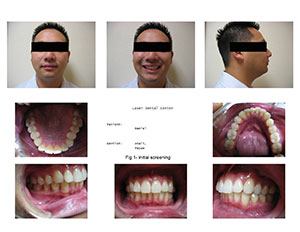 |
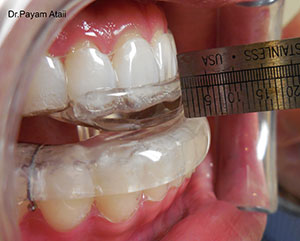 |
| Figure 1. Photos were taken during the initial screening. | Figure 2. Danny’s bite was measured traditionally. |
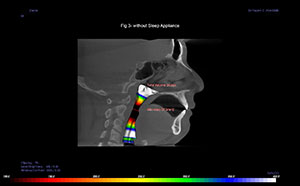 |
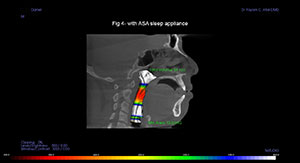 |
| Figures 3 and 4. Danny’s airway was measured without and with the sleep appliance. |
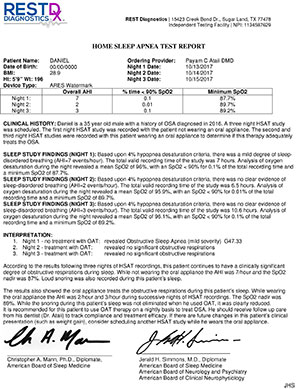 |
| Figure 5. The sleep study report verified that treatment minimized Danny’s symptoms. |
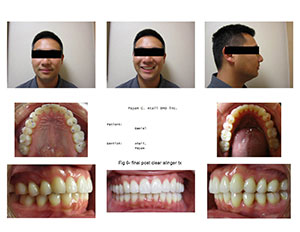 |
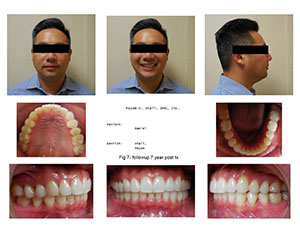 |
| Figures 6 and 7. Photos were taken immediately after treatment and seven years later. |
During the old days, this is where I got stuck. That’s because I had originally learned that all I needed to do was measure the patient’s mandible to maximum protrusion and then bring the patient back to 60% or 70%. That would be the point where I take my starting bite registration (Figure 2). Boy, little did I know back then.
At the time, appliances were fabricated to that bite. As a result, patients were complaining of joint pain or an unnoticeable improvement to their condition. I was frustrated and didn’t understand why the appliances weren’t working. “Standard protocols,” many of which today are still largely used by most practitioners providing sleep treatment, call for slow advancement of the mandible until the patient reports symptomatic improvements. So, I did just that, and my success rate was embarrassingly low.
It made no sense. I was taught that the tongue was the primary culprit for sleep apnea patients. The tongue is attached to the mandible. Move the mandible forward, and you address the problem. If only life were that simple.
The Solution
Fortunately, I finally found a solution that helped me and my staff systematically identify, treat, and manage patients with sleep breathing disorders. More than service and support, SleepArchiTx reviews each case with me and provides treatment recommendations and the most ideal appliance that the patient will wear. The company also assists me in creating that customized treatment plan for each patient.
So, back to Danny’s case. SleepArchiTx recommended that we address Danny’s malocclusion and sleep apnea through combination therapy using the Aligner Sleep Appliance (ASA) and clear aligner therapy. The patient’s malocclusion was addressed. Plus, it improved the patient’s overall airway (Figures 3 and 4).
The results were significant. Danny’s sleep apnea events were reduced from seven per hour to two per hour, which minimized his symptoms meaningfully (Figure 5). The patient’s mandible did not need to be shoved out dramatically to achieve this success. With just 1 to 2 mm of protrusion and 3 to 4 mm of tooth uprighting and vertical dimension, this patient’s condition has been stabilized for more than seven years running (Figures 6 and 7).
You might ask why the appliance is working now.
As I have come to learn, many of my patients mainly suffer from compromised velopharyngeal or nasopharyngeal spaces. The soft tissue is collapsing during sleep, causing heavy snoring or the more serious sleep apnea. That means that a compromised oropharynx is not always the case. Therefore, moving the mandible forward may not work on these types of patients. It may even be contraindicated.
Beyond delivering the appliance, I also referred Danny back to his primary care physician. SleepArchiTx also assists with coordinated care for my patients because, like Danny, who has a family history of diabetes, many sleep patients may also suffer from other medical comorbidities associated with sleep disorders, such as cardiovascular disease, excessive daytime drowsiness, and/or early death. Coordinated dental and medical follow-up are highly important. Services like these now give me the support I need to deliver great outcomes for patients with sleep breathing disorders.
Dr. Ataii is an award-winning graduate of Tufts Dental School who has treated more than 1,000 patients with clear aligners and sleep oral appliances as mono- and combo-therapies at his private practice in Laguna Hills, Calif. He has been an Invisalign faculty member for more than 10 years and was named the North America Educator of the Year in 2016 and North America Contributor of the Year in 2017. As an inventor, he has contributed in the development of patented technology including co-inventing the Aligner Sleep Appliance. Currently, Dr. Ataii serves on multiple company boards and is on the advisory board of SleepArchiTx. He can be reached at ataiidmd@gmail.com.
Disclosure
Dr. Ataii is a consultant, advisor, and stockholder with SleepArchiTx. He also is the co-patent holder of the Aligner Sleep Appliance.
Related Articles
Appliance Combines With Clear Aligners to Straighten Teeth
Carstensen Joins SleepArchiTx Advisory Board
Not All TMJ Patients Are Created Equal: A Case Study











